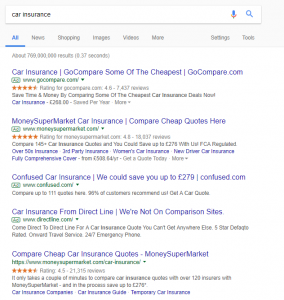
Getting PPC and SEO to work together effectively is always a key goal, whether we’re managing just one of the channels or both of them.
Although it sounds easy in principle, it’s generally not. A typical request cropping up is around sharing top-performing PPC ad copy by category and using this to update meta descriptions[1].
Sharing ad copy performance is something PPC teams should definitely be doing with their SEO counterparts; but unless your meta descriptions are awful the impact here is minimal.
This brings us to the first problem you encounter — although there is lots you CAN do, picking and prioritizing what you do when is vital[2].
The second common request is switching off PPC ads[3] when you rank in position one (P1) organically. Initially this makes perfect sense and gets the attention of sharp CMOs and CFOs. But this is the second key challenge to overcome; how do I get the right data in the right place to know if it’s actually working.
Let’s take a typical example: car insurance. Here we see MoneySuperMarket ranking P1 organically:
The inevitable push comes; can we turn PPC off in [car insurance] because it’s really expensive and we’re ranking P1 organically.
Well, probably not. Yes, your report is accurate: you rank P1 organically. But you’re actually the fifth result on that page. On my work monitor the organic ranking is well past halfway down the page. On mobile you’re well below the fold:
This is where getting the right data is key.
Keyword universe
One way in which we’re improving SEM data for our clients is via a Keyword Universe. This isn’t perfect by



